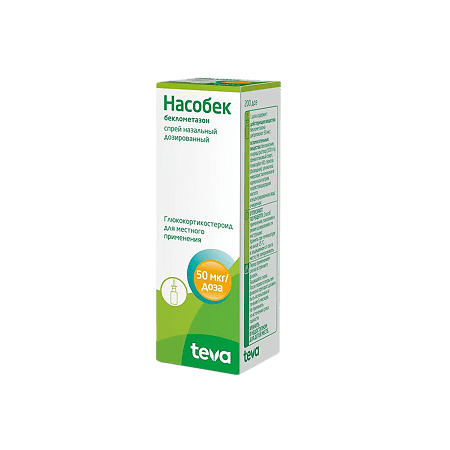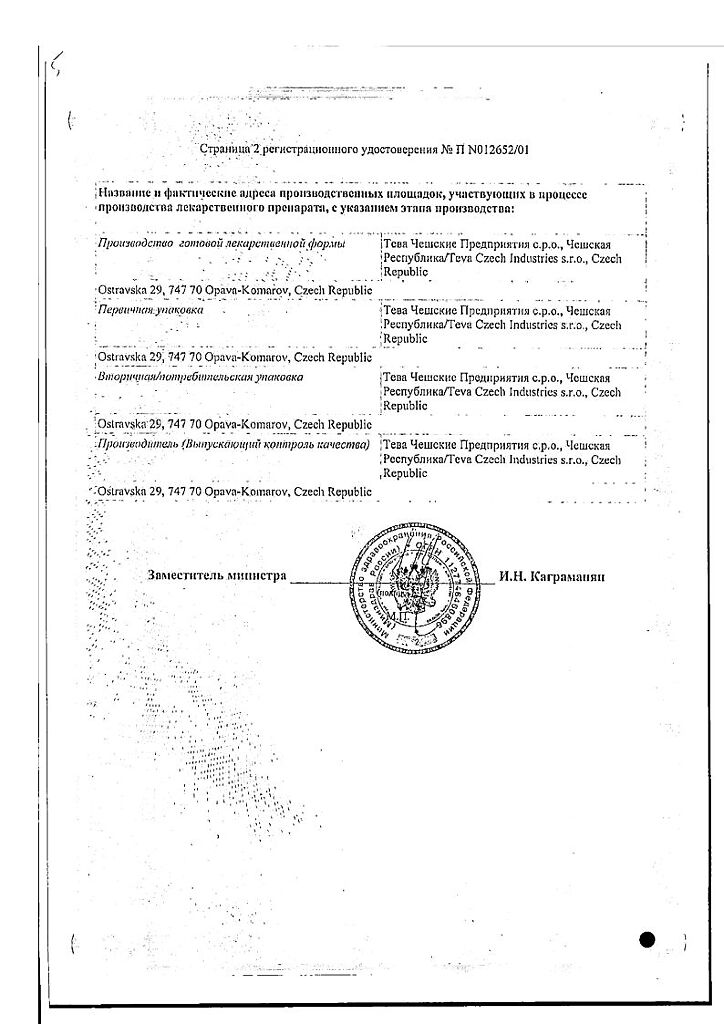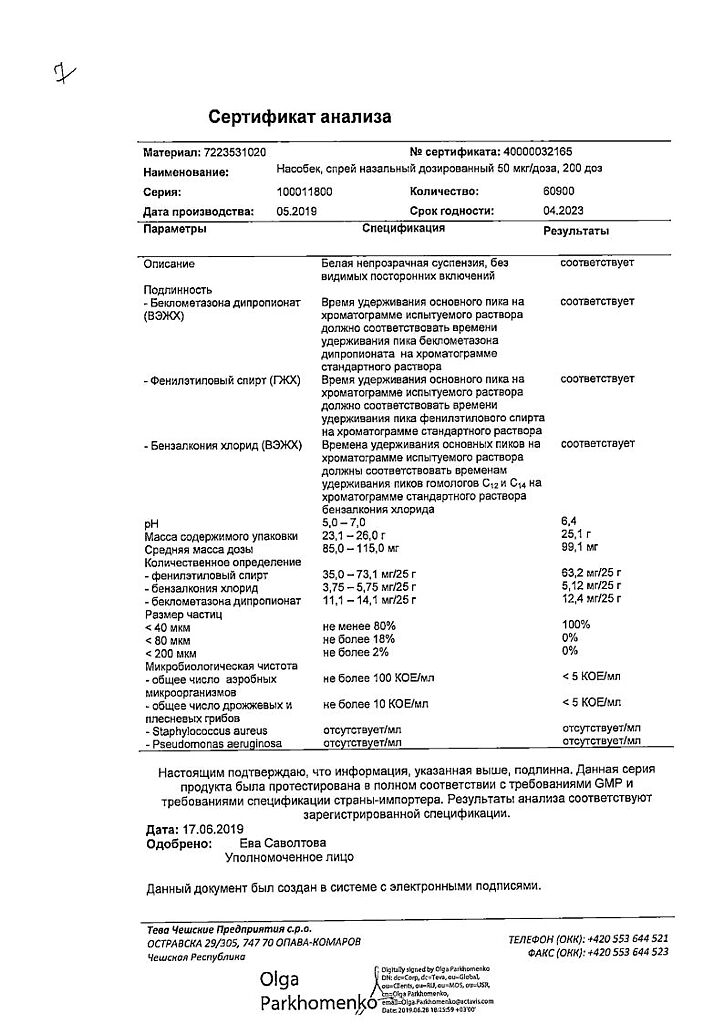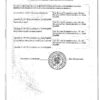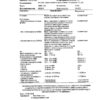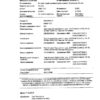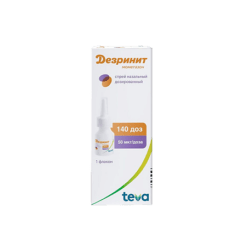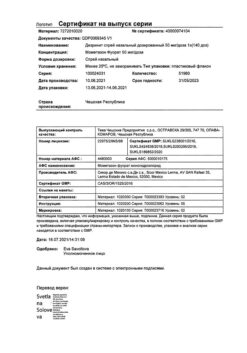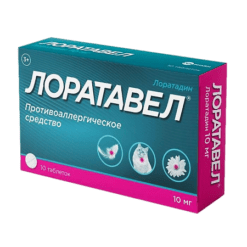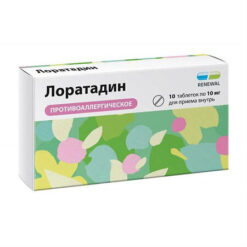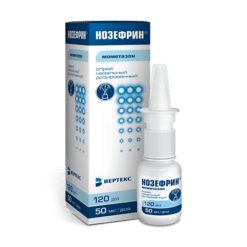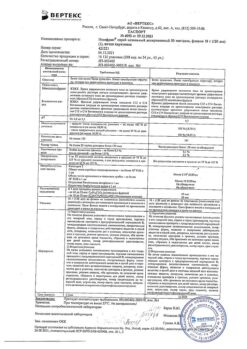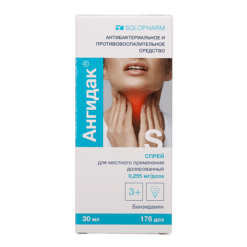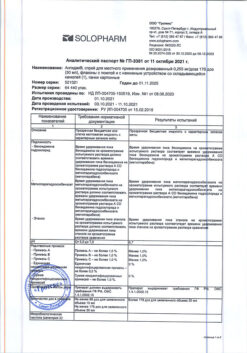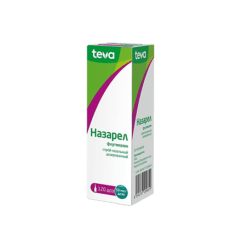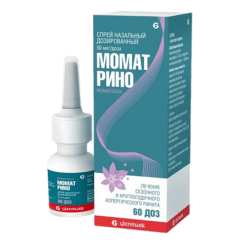No products in the cart.
Nasobec, spray 50 mcg/dose 120 doses
€6.09 €5.41
Out of stock
(E-mail when Stock is available)
Description
Pharmacotherapeutic group: glucocorticosteroid for topical use
ATX code: R01AD01
Pharmacological properties
Pharmacodynamics
Beclomethasone is a synthetic glucocorticosteroid (GCS) for topical use and has anti-inflammatory, anti-allergic and immunosuppressive effects. It increases the production of lipomodulin, which is an inhibitor of phospholipase A, inhibits the release of arachidonic acid. It prevents marginal accumulation of neutrophils, reduces inflammatory exudation and lymphokine production, inhibits macrophage migration, reduces the intensity of infiltration and granulation processes, chemotaxis substance formation. Reduces nasal mucosal edema and mucus production. It improves mucociliary transport. It is well tolerated with long-term treatment, has no mineralocorticoid activity, has almost no resorptive effect.
Pharmacokinetics
When administered by inhalation in the recommended doses, it has no significant systemic activity. After intranasal administration it is rapidly absorbed in the nasal mucosa. Part of the injected beclomethasone is swallowed. Most of the beclomethasone that enters the gastrointestinal (GI) tract is inactivated on “first passage” through the liver. Gastrointestinal absorption is low. Plasma protein binding is 87%. Excretion of beclomethasone dipropionate and the highly active metabolite beclomethasone-17-monopropionate are characterized by high plasma clearance (150 and 120 l/h), with elimination half-lives of 0.5 hours and 2.7 hours, respectively. The main part of beclomethasone (35-76%), regardless of the method of administration, is excreted through the intestine within 96 hours mainly as polar metabolites, 10-15% – by the kidneys.
Indications
Indications
Active ingredient
Active ingredient
Composition
Composition
How to take, the dosage
How to take, the dosage
Intranasally.
Adults and children over 6 years
Two doses (100 mcg) in each nasal passage twice daily (400 mcg/day). The maximum daily dose is 400 mcg/day. Some patients are recommended to use one dose (50 mcg) in each nasal passage 3-4 times a day.
When therapeutic effect is achieved, the dose should be reduced to one dose (50 mcg) twice daily in each nasal passage (200 mcg/day). Each patient should be given the lowest possible dose that provides effective symptom control.
The patient should be told that it takes several days to achieve a therapeutic effect.
If the patient does not improve after three weeks of therapy, it is recommended that the drug be discontinued.
Elderly patients
Patients do not need dose adjustment.
Patient recommendations for use of the drug
The nasal passages should be cleared before using the drug.
The first time you use the sprayer should be unblocked by pressing the pipette a few times until the aerosol cloud appears. If the product has not been used for several days, re-lock the sprayer.
Before using the product for the first time, remove the plastic protective half-ring between the threaded part and the dispensing nasal applicator.
When the product is finished, clean the tip (top) of the applicator with a clean cloth and replace the cap.
Cleaning the applicator
The nasal applicator should be cleaned at least once a week to prevent the possibility of clogging.
To do this, gently press down on the bottom of the applicator and disconnect the nasal applicator.
Wash the applicator and cap with warm water and allow to dry.
Then place the applicator and cap back on the bottle.
Interaction
Interaction
Special Instructions
Special Instructions
Systemic adverse effects of nasal GCS may occur primarily when high doses are administered over an extended period of time. The likelihood of adverse reactions is much lower than with oral GCS. Possible systemic effects include: Cushing’s syndrome, characteristic cushingoid signs, adrenal suppression, growth retardation in children and adolescents, cataract and glaucoma, behavior changes (especially in children): hyperactivity, sleep disturbances, agitation, depression or aggression.
In long-term use of Nasobec in children, the dynamics of their growth should be controlled. If growth slows, consideration should be given to reducing the dose of nasal GCS, if possible, to the lowest effective dose that controls the course of the disease.
Particular attention should be given to patients during their transition from systemic hormone therapy to Nasobec, during which time the hypothalamic-pituitary-adrenal system may manifest.
Nasobec should also be used with caution in patients with glaucoma, septal ulceration, and recent nasal trauma.
The use of Nasobec at higher doses than recommended may result in clinically significant inhibition of adrenal function. If patients use higher than recommended doses, additional systemic hormones should be evaluated in case of elective surgery or in times of stress.
In most patients, Nasobec resolves symptoms of seasonal allergic rhinitis, but in some cases, especially with very high airborne allergens, additional therapy may be necessary, especially for eye symptoms.
Contraindications
Contraindications
Hypersensitivity to beclomethasone and other components of the drug, hemorrhagic diathesis, nasal bleeding, pulmonary tuberculosis, children under 6 years of age, pregnancy (I trimester), viral and fungal diseases.
With caution
Nasal septal ulcerations, recent nasal surgery, recent nasal trauma, glaucoma, pregnancy (II-III trimesters), breast-feeding.
Side effects
Side effects
The frequency of side effects is classified according to the World Health Organization recommendations: very common (⥠1/10); common (⥠1/100 to < 1/10); infrequent (⥠1/1000 to < 1/100); rare (⥠1/10000 to < 1/1000); very rare (< 1/10000, including isolated cases); unknown – there are not enough data to estimate the frequency of occurrence in the population.
Immune system disorders: rare – hypersensitivity reactions, including skin rash, urticaria, redness and swelling of the face, eyes, lips, throat; very rare – shortness of breath and/or bronchospasm, anaphylactic reactions.
Nervous system disorders: rare – disorders of olfactory and gustatory sensations, headache.
Visual organ: rarely – increased intraocular pressure, including glaucoma; very rarely – cataracts; unknown – visual impairment, central serous chorioretinopathy (CCP) (see section “Special indications”).
As for the respiratory system, thorax and mediastinum: frequently – dryness and irritation of the nasopharynx, sneezing, nasal bleeding, ulceration of the nasal mucosa, perforation of the nasal septum.
Others: unknown – with long-term use in high doses development of adrenal insufficiency, growth retardation in children is possible (see also section “Special Precautions”).
Overdose
Overdose
Pregnancy use
Pregnancy use
It is allowed only when the expected benefit to the mother outweighs the possible risk to the fetus. Caution should be exercised when treating with Nasobec during breastfeeding.
Similarities
Similarities
Additional information
| Shelf life | 4 years. After the first opening of the bottle the drug must be used within 6 months. Do not use after the expiration date. |
|---|---|
| Conditions of storage | Store at a temperature not higher than 25 ºC, in a light-protected place. Do not freeze. KEEP OUT OF REACH OF CHILDREN. |
| Manufacturer | Teva Czech Enterprises s.r.o., Czech Republic |
| Medication form | nasal spray |
| Brand | Teva Czech Enterprises s.r.o. |
Related products
Buy Nasobec, spray 50 mcg/dose 120 doses with delivery to USA, UK, Europe and over 120 other countries.

